Indexed in: ESCI, Scopus, PubMed,
PubMed Central, CAS, DOAJ, KCI
PubMed Central, CAS, DOAJ, KCI
FREE article processing charge

Previous issues
- Page Path
- HOME > Browse Articles > Previous issues
Imagery
- "Lanterns carrying hopes and dreams"
- J Yeungnam Med Sci. 2023;40(1):i. Published online July 18, 2022
- DOI: https://doi.org/10.12701/jyms.2022.00416

- 1,670 View
- 51 Download
Editorial
- Appreciation to peer reviewers in 2022
- So-Young Park
- J Yeungnam Med Sci. 2023;40(1):1-3. Published online January 13, 2023
- DOI: https://doi.org/10.12701/jyms.2022.00920
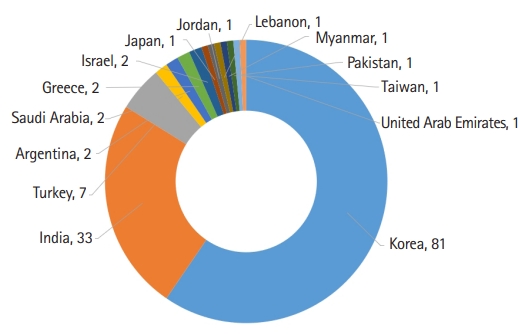
- 1,602 View
- 91 Download
- 1 Web of Science
- 1 Crossref
-
 PDF
PDF Supplementary Material
Supplementary Material -
Citations
Citations to this article as recorded by- Journal of Yeungnam Medical Science is indexed in Emerging Sources Citation Index (ESCI)
So-Young Park
Journal of Yeungnam Medical Science.2023; 40(4): 317. CrossRef
- Journal of Yeungnam Medical Science is indexed in Emerging Sources Citation Index (ESCI)
Review articles
- Beneficial effects of intermittent fasting: a narrative review
- Dae-Kyu Song, Yong-Woon Kim
- J Yeungnam Med Sci. 2023;40(1):4-11. Published online April 4, 2022
- DOI: https://doi.org/10.12701/jyms.2022.00010
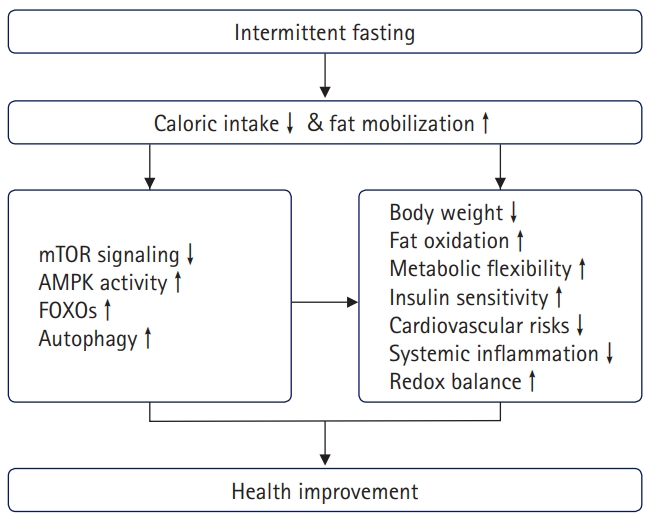
- 7,491 View
- 386 Download
- 4 Web of Science
- 9 Crossref
-
 Abstract
Abstract
 PDF
PDF - Caloric restriction is a popular approach to treat obesity and its associated chronic illnesses but is difficult to maintain for a long time. Intermittent fasting is an alternative and easily applicable dietary intervention for caloric restriction. Moreover, intermittent fasting has beneficial effects equivalent to those of caloric restriction in terms of body weight control, improvements in glucose homeostasis and lipid profiles, and anti-inflammatory effects. In this review, the beneficial effects of intermittent fasting are discussed.
-
Citations
Citations to this article as recorded by- Intermittent fasting and longevity: From animal models to implication for humans
Olha Strilbytska, Svitlana Klishch, Kenneth B. Storey, Alexander Koliada, Oleh Lushchak
Ageing Research Reviews.2024; 96: 102274. CrossRef - Combined Aerobic Exercise with Intermittent Fasting Is Effective for Reducing mTOR and Bcl-2 Levels in Obese Females
Purwo Sri Rejeki, Adi Pranoto, Deandra Maharani Widiatmaja, Dita Mega Utami, Nabilah Izzatunnisa, Sugiharto, Ronny Lesmana, Shariff Halim
Sports.2024; 12(5): 116. CrossRef - Effect of Intermittent Fasting Interventions for Treatment of Overweight and Obesity in Adults – A Systematic Review
Teena Lal, S. J. Ajeet Arulkumar, S. Roopa
Acta Medica International.2024; 11(1): 7. CrossRef - Intermittent fasting influences immunity and metabolism
Daniel M. Marko, Meghan O. Conn, Jonathan D. Schertzer
Trends in Endocrinology & Metabolism.2024;[Epub] CrossRef - Intermittent Fasting Improves Social Interaction and Decreases Inflammatory Markers in Cortex and Hippocampus
Martín García-Juárez, Adamary García-Rodríguez, Gabriela Cruz-Carrillo, Orlando Flores-Maldonado, Miguel Becerril-Garcia, Lourdes Garza-Ocañas, Ivan Torre-Villalvazo, Alberto Camacho-Morales
Molecular Neurobiology.2024;[Epub] CrossRef - Impact of Intermittent Fasting and Dietary Restriction on Redox State, Energetic Metabolism, and Liver Injury in Common Bile Duct Ligation Model
Dmitry S. Semenovich, Ljubava D. Zorova, Polina A. Abramicheva, Nadezda V. Andrianova, Andrey V. Elchaninov, Aleksandra S. Petrukhina, Irina B. Pevzner, Vasily N. Manskikh, Dmitry B. Zorov, Egor Y. Plotnikov
Antioxidants.2024; 13(7): 835. CrossRef - DOSE: a lifestyle philosophy for dementia prevention informed by drug development and epidemiology
Timothy Daly
Dementia & Neuropsychologia.2024;[Epub] CrossRef - Maternal intermittent fasting deteriorates offspring metabolism via suppression of hepatic mTORC1 signaling
Wenzhen Yin, Lijun Sun, Yuan Liang, Chao Luo, Tiange Feng, Yunhua Zhang, Weizhen Zhang, Yue Yin
The FASEB Journal.2023;[Epub] CrossRef - Time-Restricted Feeding and Intermittent Fasting as Preventive Therapeutics: A Systematic Review of the Literature
Arturo P Jaramillo, Javier Castells, Sabina Ibrahimli, Luisa Jaramillo, Rebeca R Briones Andriuoli, Denisse Moncada, Jhoanny C Revilla
Cureus.2023;[Epub] CrossRef
- Intermittent fasting and longevity: From animal models to implication for humans
- Long-term management of Graves disease: a narrative review
- Hyo-Jeong Kim
- J Yeungnam Med Sci. 2023;40(1):12-22. Published online November 4, 2022
- DOI: https://doi.org/10.12701/jyms.2022.00444
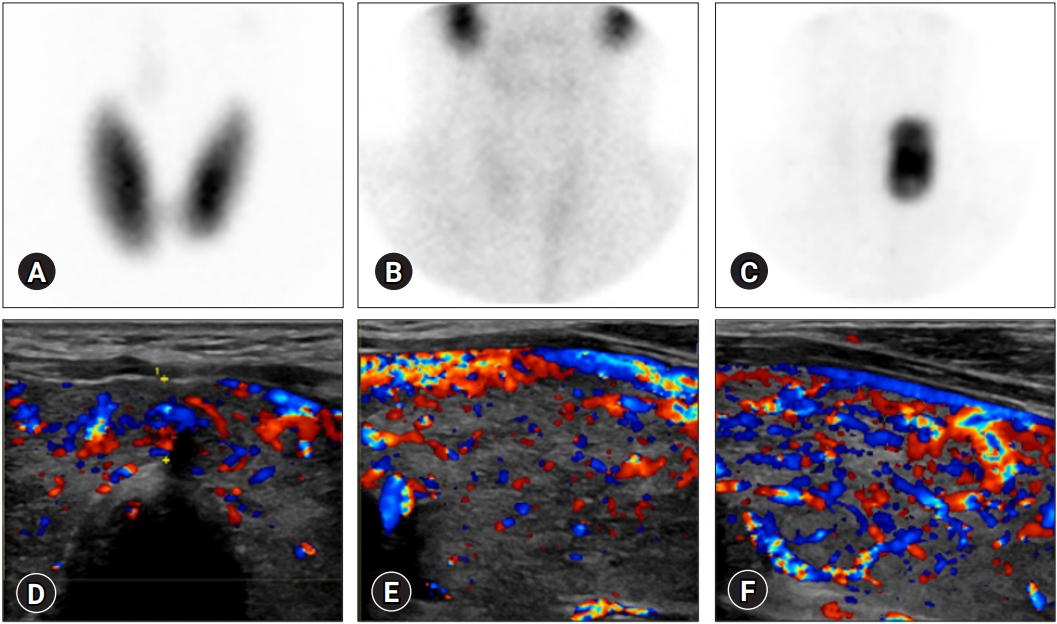
- 8,293 View
- 365 Download
- 3 Web of Science
- 4 Crossref
-
 Abstract
Abstract
 PDF
PDF - Graves disease (GD) is the most common cause of hyperthyroidism, accounting for more than 90% of cases in Korea. Patients with GD are treated with any of the following: antithyroid drugs (ATDs), radioactive iodine (RAI) therapy, or thyroidectomy. Most patients begin treatment with ATDs, and clinical guidelines suggest that the appropriate treatment period is 12 to 18 months. While RAI treatment and surgery manage thyrotoxicosis by destroying or removing thyroid tissue, ATDs control thyrotoxicosis by inhibiting thyroid hormone synthesis and preserving the thyroid gland. Although ATDs efficiently control thyrotoxicosis symptoms, they do not correct the main etiology of GD; therefore, frequent relapses can follow. Recently, a large amount of data has been collected on long-term ATDs for GD, and low-dose methimazole (MMZ) is expected to be a good option for remission. For the long-term management of recurrent GD, it is important to induce remission by evaluating the patient’s drug response, stopping ATDs at an appropriate time, and actively switching to surgery or RAI therapy, if indicated. Continuing drug treatment for an extended time is now encouraged in patients with a high possibility of remission with low-dose MMZ. It is also important to pay attention to the quality of life of the patients. This review aimed to summarize the appropriate treatment methods and timing of treatment transition in patients who relapsed several times while receiving treatment for GD.
-
Citations
Citations to this article as recorded by- Commentary: Azathioprine as an adjuvant therapy in severe Graves’ disease: a randomized controlled open-label clinical trial
Madhukar Mittal, Azher Rizvi
Frontiers in Endocrinology.2024;[Epub] CrossRef - Total Thyroidectomy – A Cost-effective Alternative to Anti-Thyroid Drugs in the Management of Grave's Disease
Erivelto Volpi, Leonardo M. Volpi
Clinical Thyroidology.2023; 35(5): 183. CrossRef - Evaluation of the Abbott Alinity i Thyroid-Stimulating Hormone Receptor Antibody (TRAb) Chemiluminescent Microparticle Immunoassay (CMIA)
Deborah J. W. Lee, Soon Kieng Phua, Yali Liang, Claire Chen, Tar-Choon Aw
Diagnostics.2023; 13(16): 2707. CrossRef - Mechanisms and Treatment Options for Hyperthyroid-Induced Osteoporosis: A Narrative Review
Robert M Branstetter, Rahib K Islam, Collin A Toups, Amanda N Parra, Zachary Lee, Shahab Ahmadzadeh, Giustino Varrassi, Sahar Shekoohi, Alan D Kaye
Cureus.2023;[Epub] CrossRef
- Commentary: Azathioprine as an adjuvant therapy in severe Graves’ disease: a randomized controlled open-label clinical trial
- The use of animal models in rheumatoid arthritis research
- Jin-Sun Kong, Gi Heon Jeong, Seung-Ah Yoo
- J Yeungnam Med Sci. 2023;40(1):23-29. Published online November 22, 2022
- DOI: https://doi.org/10.12701/jyms.2022.00773

- 4,131 View
- 266 Download
- 2 Web of Science
- 4 Crossref
-
 Abstract
Abstract
 PDF
PDF - The pathological hallmark of rheumatoid arthritis (RA) is a synovial pannus that comprises proliferating and invasive fibroblast-like synoviocytes, infiltrating inflammatory cells, and an associated neoangiogenic response. Animal models have been established to study these pathological features of human RA. Spontaneous and induced animal models of RA primarily reflect inflammatory aspects of the disease. Among various induced animal models, collagen-induced arthritis (CIA) and collagen antibody-induced arthritis (CAIA) models are widely used to study the pathogenesis of RA. Improved transplantation techniques for severe combined immunodeficiency (SCID) mouse models of RA can be used to evaluate the effectiveness of potential therapeutics in human tissues and cells. This review provides basic information on various animal models of RA, including CIA and CAIA. In addition, we describe a SCID mouse coimplantation model that can measure the long-distance migration of human RA synoviocytes and cartilage destruction induced by these cells.
-
Citations
Citations to this article as recorded by- CRISPRa engineered Elite macrophages enable adoptive cell therapy for rheumatoid arthritis
Yuhong Huang, Zhuqian Wang, Chuanxin Zhong, Hongzhen Chen, Xinxin Chen, Chunhao Cao, Fang Qiu, Duoli Xie, Jin Li, Jie Li, Xu Yang, Aiping Lu, Xuekun Fu, Chao Liang
The Innovation Medicine.2024; 2(1): 100050. CrossRef - Microenvironmental Enzyme-Responsive Methotrexate Modified Quercetin Micelles for the Treatment of Rheumatoid Arthritis
Xiuying Li, Xin Wang, Xiuwu Qu, Ningning Shi, Qinqing Li, Zhifang Yan, Yandong Li, Yingli Wang
International Journal of Nanomedicine.2024; Volume 19: 3259. CrossRef - Clinical Phenotypes, Serological Biomarkers, and Synovial Features Defining Seropositive and Seronegative Rheumatoid Arthritis: A Literature Review
James Perera, Chiara Aurora Delrosso, Alessandra Nerviani, Costantino Pitzalis
Cells.2024; 13(9): 743. CrossRef - Emerging Landscape of In Vitro Models for Assessing Rheumatoid Arthritis Management
Abhay Prakash Mishra, Rajesh Kumar, Seetha Harilal, Manisha Nigam, Deepanjan Datta, Sudarshan Singh
ACS Pharmacology & Translational Science.2024;[Epub] CrossRef
- CRISPRa engineered Elite macrophages enable adoptive cell therapy for rheumatoid arthritis
Original articles
- Incidence of congenital hypothyroidism by gestational age: a retrospective observational study
- Ha Young Jo, Eun Hye Yang, Young Mi Kim, Soo-Han Choi, Kyung Hee Park, Hye Won Yoo, Su Jeong Park, Min Jung Kwak
- J Yeungnam Med Sci. 2023;40(1):30-36. Published online April 12, 2022
- DOI: https://doi.org/10.12701/jyms.2022.00059
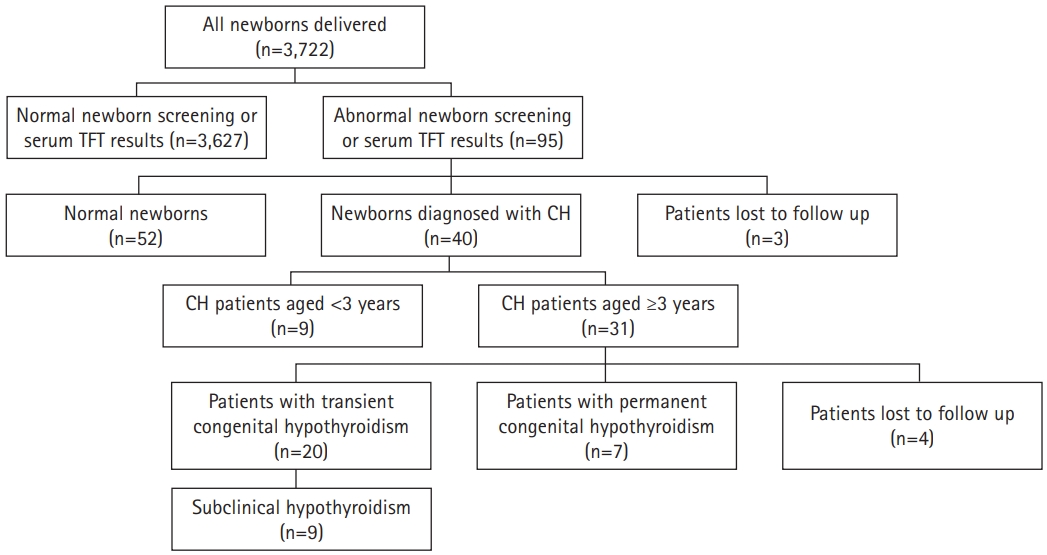
- 3,303 View
- 143 Download
- 2 Web of Science
- 2 Crossref
-
 Abstract
Abstract
 PDF
PDF - Background
Congenital hypothyroidism (CH) is the leading cause of preventable physical and intellectual disabilities. This study aimed to assess the incidence and clinical characteristics of CH in newborns.
Methods
We retrospectively reviewed the medical records of all newborns delivered at the Pusan National University Hospital between January 2011 and March 2021. The incidence of CH was compared according to gestational age, birth weight, and small for gestational age (SGA). The patients aged ≥3 years who could not maintain normal thyroid function and required levothyroxine treatment were diagnosed with permanent CH. Logistic regression analysis was performed to compare CH risks.
Results
Of 3,722 newborns, 40 were diagnosed with CH (1.07%). Gestational age and birth weight were significantly associated with CH incidence. The odds ratios (ORs) of CH in infants delivered at 32–37, 28–31, and <28 weeks were 2.568 (95% confidence interval [CI], 1.141–5.778), 5.917 (95% CI, 2.264–15.464), and 7.441 (95% CI, 2.617–21.159) times higher, respectively, than those delivered at term. The ORs of CH in infants weighing 1,500–2,499 g, 1,000–1,499 g, and <1,000 g were 4.664 (95% CI, 1.928–11.279), 11.076 (95% CI, 4.089–29.999), and 12.544 (95% CI, 4.350–36.176) times greater, respectively, than those in infants weighing ≥2,500 g. The OR of CH was 6.795 (95% CI, 3.553–13.692) times greater in SGA than in non-SGA infants.
Conclusion
The CH incidence in South Korea has increased significantly compared with that in the past. Gestational age, birth weight, and SGA were significantly associated with CH incidence. -
Citations
Citations to this article as recorded by- History of Neonatal Screening of Congenital Hypothyroidism in Portugal
Maria José Costeira, Patrício Costa, Susana Roque, Ivone Carvalho, Laura Vilarinho, Joana Almeida Palha
International Journal of Neonatal Screening.2024; 10(1): 16. CrossRef - The prevalence of hypothyroxinemia in premature newborns
Renata Stawerska, Marzena Nowak-Bednarek, Tomasz Talar, Marzena Kolasa-Kicińska, Anna Łupińska, Maciej Hilczer, Ewa Gulczyńska, Andrzej Lewiński
Frontiers in Endocrinology.2022;[Epub] CrossRef
- History of Neonatal Screening of Congenital Hypothyroidism in Portugal
- Factors associated with the prescription of probiotics in patients with inflammatory bowel disease: a cross-sectional study
- Joo Kyung Kim, Jae Hee Cheon
- J Yeungnam Med Sci. 2023;40(1):37-48. Published online April 18, 2022
- DOI: https://doi.org/10.12701/jyms.2022.00031
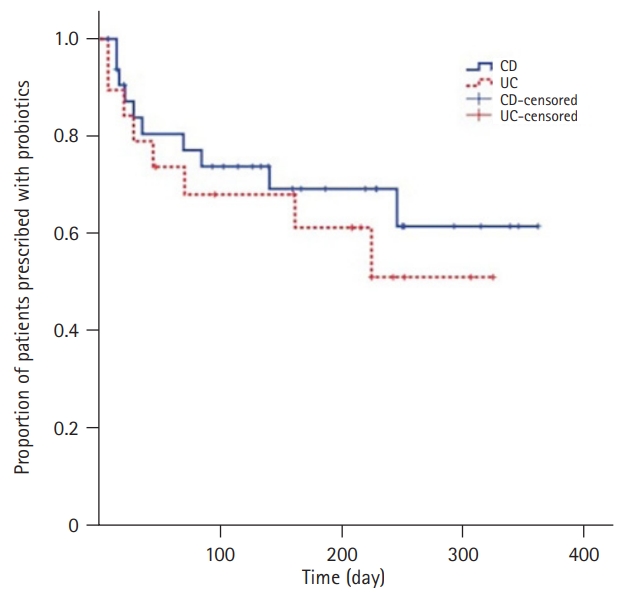
- 3,658 View
- 95 Download
- 1 Web of Science
- 1 Crossref
-
 Abstract
Abstract
 PDF
PDF - Background
Commensal bacteria play an important role in the pathogenesis of inflammatory bowel disease (IBD) and probiotics have been used as treatment options. We aimed to explore the current use of probiotics and factors associated with their prescription in patients with IBD.
Methods
This cross-sectional study was conducted on a single hospital-based cohort. Patients were eligible if they were ≥18 years old, visited the IBD clinic as an outpatient more than twice during the study period, and had a confirmed diagnosis of IBD. Patients were divided into two groups based on the prescription of probiotics. Clinical assessments were compared between the two groups.
Results
In total, 217 patients were enrolled in this study. In patients with Crohn disease (CD), moderate or severe abdominal pain; prior use of methotrexate (MTX), iron, thiopurines, or biologics; history of IBD-related surgery; and stool frequency were independently associated with the prescription of probiotics. In patients with ulcerative colitis (UC), moderate or severe abdominal pain, hematochezia, stool frequency, and moderate or severe physician global assessment score were independently associated with the prescription of probiotics.
Conclusion
Increased disease activity may be associated with fewer prescriptions of probiotics in patients with IBD. However, physicians prescribed probiotics to control symptoms, such as abdominal pain and increased stool frequency in patients with UC and CD, and hematochezia in patients with UC. Additionally, the use of MTX and iron, and a history of IBD-related surgeries were associated with more frequent probiotic prescriptions in patients with CD. -
Citations
Citations to this article as recorded by- Probiotics for the treatment of ulcerative colitis: a review of experimental research from 2018 to 2022
Cuilan Huang, Wujuan Hao, Xuyang Wang, Renmin Zhou, Qiong Lin
Frontiers in Microbiology.2023;[Epub] CrossRef
- Probiotics for the treatment of ulcerative colitis: a review of experimental research from 2018 to 2022
- The impact of quality of life measured by WHOQOL-BREF on mortality in maintenance hemodialysis patients: a single center retrospective cross-sectional study
- Seong Gyu Kim, In Hee Lee
- J Yeungnam Med Sci. 2023;40(1):49-57. Published online April 18, 2022
- DOI: https://doi.org/10.12701/jyms.2022.00080
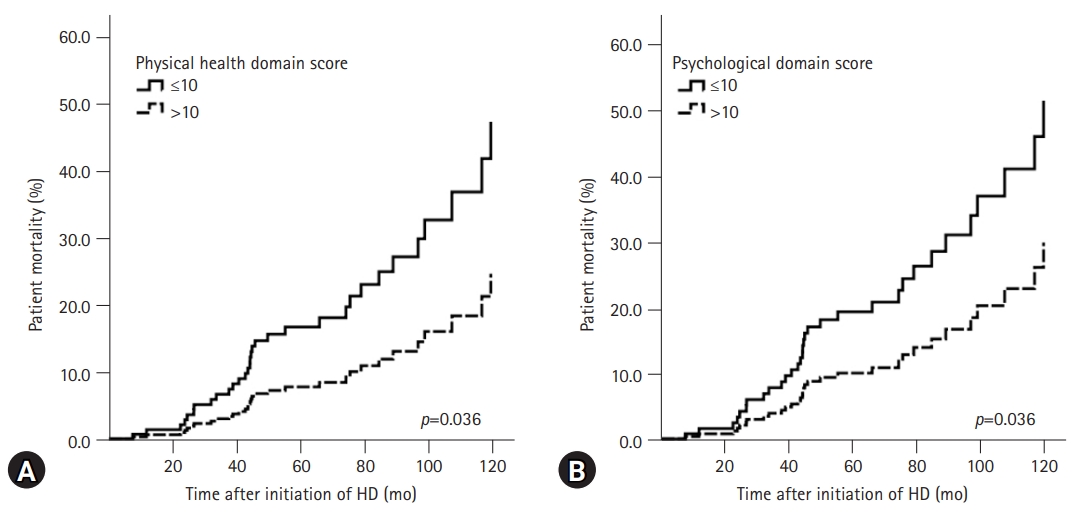
- 2,491 View
- 86 Download
- 2 Web of Science
- 1 Crossref
-
 Abstract
Abstract
 PDF
PDF - Background
Several previous studies have reported that quality of life (QoL) in hemodialysis patients affects mortality. However, the 36-item Short Form Health Survey, which has been used mainly in previous studies, is complicated in terms of questionnaire composition and interpretation. This study aimed to identify the impact of QoL on mortality in hemodialysis patients using an easier and simpler diagnostic tool.
Methods
This retrospective study included 160 hemodialysis patients. QoL was evaluated using the World Health Organization Quality of Life Questionnaire-Brief version (WHOQOL-BREF). Psychosocial factors were evaluated using the Hospital Anxiety and Depression Scale, Multidimensional Scale of Perceived Social Support, Montreal Cognitive Assessment, and Pittsburgh Sleep Quality Index. We also evaluated medical factors, such as dialysis adequacy and laboratory results.
Results
The mean hemodialysis vintage was 70.7±38.0 months. The proportion of patients who were elderly was higher in the mortality group than in the surviving group, and the Charlson Comorbidity Index score was also higher in the former group. Of the four domains of the WHOQOL-BREF, the physical health and psychological scores of the mortality group were significantly lower than those of the survival group. When the score in the physical health domain or psychological domain was ≤10, the 10-year mortality rate after hemodialysis initiation increased by approximately 2.3- and 2-fold, respectively.
Conclusion
QoL may have a significant effect on mortality in patients undergoing hemodialysis. The WHOQOL-BREF is an instrument that can measure QoL relatively easily and can be used to improve the long-term prognosis of patients undergoing hemodialysis. -
Citations
Citations to this article as recorded by- Application of standardized management and effect evaluation of chronic obstructive pulmonary disease patients using the big data center of the Internet of Things
Xiaoping Chen, Fei He, Yan Jiang, Xuezhen Chen, Yubing Yan
DIGITAL HEALTH.2024;[Epub] CrossRef
- Application of standardized management and effect evaluation of chronic obstructive pulmonary disease patients using the big data center of the Internet of Things
- Satisfaction of industrial health care managers regarding the work of industrial hygiene engineers: a cross-sectional study
- Byung Sik Choi, Min Keun Kim, Joon Sakong
- J Yeungnam Med Sci. 2023;40(1):58-64. Published online May 24, 2022
- DOI: https://doi.org/10.12701/jyms.2022.00073

- 2,227 View
- 52 Download
-
 Abstract
Abstract
 PDF
PDF - Background
A group health service is a system that delegates workplace health management to an entrusted institution. There have been various studies on group health services to date, but recent changes, such as an increase in foreign workers, are rapidly changing industry characteristics.
Methods
Satisfaction was assessed using a 27-question survey distributed among 203 workplaces employing health professionals. The survey items consisted of general characteristics, comprehensive satisfaction, requirements for health professionals’ work, and satisfaction with work environment management, ergonomic management, and healthcare management. Multiple regression and frequency analyses were performed.
Results
The comprehensive satisfaction was 4.08 points on average, out of 5. The comprehensive satisfaction of health professionals in the industry was positively correlated with each factor. Hazardous materials and chemical management (material safety data sheets, MSDSs) were the most common requirements.
Conclusion
A low level of satisfaction with work environment management indicates high demand for healthcare management. The working environment should be improved by identifying characteristics of the workplace, examining harmful substances, inspecting equipment, and enhancing worker methods. The shorter the work experience of health professionals, the more dependent they are on group health services. The variables affecting comprehensive satisfaction were the period of work, healthcare management satisfaction, and work environment management satisfaction. Most of the requirements of health professionals in the workplace were practical improvement case presentations, MSDSs, and legal document management.
- The effect and therapeutic compliance of adjuvant therapy in patients with cholangiocarcinoma after R0 resection: a retrospective study
- Han Taek Jeong, Joonkee Lee, Hyeong Ho Jo, Ho Gak Kim, Jimin Han
- J Yeungnam Med Sci. 2023;40(1):65-77. Published online May 26, 2022
- DOI: https://doi.org/10.12701/jyms.2022.00213
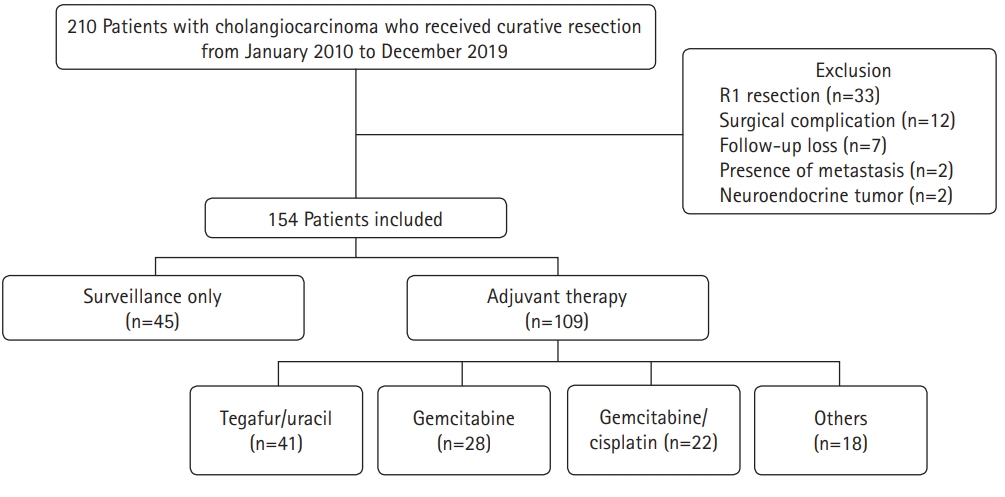
- 3,296 View
- 62 Download
- 1 Web of Science
- 1 Crossref
-
 Abstract
Abstract
 PDF
PDF - Background
This study aimed to compare clinical outcomes between surveillance and adjuvant therapy (AT) groups after R0 resection for cholangiocarcinoma (CCA).
Methods
A total of 154 patients who underwent R0 resection for CCA at the Daegu Catholic University Medical Center between January 2010 and December 2019 were included. Overall survival (OS) and progression-free survival (PFS) were analyzed.
Results
The median follow-up duration was 899 days. There were 109 patients in the AT group and 45 patients in the surveillance group. The patients in the AT group were younger (67 years vs. 74 years, p<0.001) and included more males (64.2% vs. 46.7%, p=0.044). The proportion of patients with stage III CCA was larger in the AT group than in the surveillance group (13.8% vs. 2.2%, p=0.005). In addition, AT did not improve OS (5-year OS rate, 69.3% in the AT group vs. 64.2% in the surveillance group, p=0.806) or PFS (5-year PFS rate, 42.6% in the AT group vs. 48.9% in the surveillance group, p=0.113). In multivariate analysis using the Cox proportional hazards model, stage III CCA (hazard ratio [HR], 10.81; 95% confidence interval [CI], 2.92–40.00; p<0.001) was a significant predictor of OS. American Society of Anesthesiologists classification II (HR, 0.50; 95% CI, 0.31–0.81; p=0.005), and American Joint Committee on Cancer stages II (HR, 3.14; 95% CI, 1.25–7.89; p=0.015) and III (HR, 8.08; 95% CI, 2.80–23.32; p<0.001) were independent predictors of PFS.
Conclusion
AT after R0 resection for CCA did not improve OS or PFS. -
Citations
Citations to this article as recorded by- Robotic Complete ALPPS (rALPPS)—First German Experiences
Jörg Arend, Mareike Franz, Alexander Rose, Christine March, Mirhasan Rahimli, Aristotelis Perrakis, Eric Lorenz, Roland Croner
Cancers.2024; 16(5): 1070. CrossRef
- Robotic Complete ALPPS (rALPPS)—First German Experiences
- Auricular acupuncture for sleep quality in participants with mental and behavioral disorders due to prior multiple drug use: a retrospective consecutive case series
- Yuri Gimelfarb, Eran Goldstien
- J Yeungnam Med Sci. 2023;40(1):78-85. Published online November 28, 2022
- DOI: https://doi.org/10.12701/jyms.2022.00542

- 3,429 View
- 102 Download
-
 Abstract
Abstract
 PDF
PDF - Background
Poor sleep quality is associated with psychoactive substance abuse/addiction/withdrawal. Auricular acupuncture (AA) is a nonpharmacological method used for the treatment of sleep disturbances. This study aimed to examine the quality of sleep before and after AA in participants with mental and behavioral disorders due to prior multiple drug use in the therapeutic community.
Methods
This was a consecutive case series of 27 participants (25 male [92.6%]). The median age was 35.0 years (interquartile range [IQR], 29.0–37.2 years), methadone/buprenorphine were not used, and the participants were treated with AA (median number of treatments, 15.0 [IQR, 12.0–18.0]) during a median period of 51.0 days (IQR, 49.0–51.0 days) according to the National Acupuncture Detoxification Association (NADA)-Acudetox protocol. Sleep quality was determined using the Pittsburgh Sleep Quality Index (PSQI), a self-rated questionnaire that assesses sleep quality and disturbances over a 1-month interval.
Results
The global PSQI score dropped (indicating better sleep quality) by a median of 3.0 points (IQR, 0.0–8.0 points) after treatment. In the multivariate logistic regression analysis, with an increase in global PSQI score during AA by 1 point, there was a 0.73-fold reduction in the risk of poor sleep quality post-AA (adjusted odds ratio, 0.73; 95% confidence interval, 0.52–1.01; p<0.055; Nagelkerke's R2=0.66).
Conclusion
The results revealed a positive effect of AA (by the NADA-Acudetox protocol) on sleep quality (as measured by PSQI) among participants in a treatment center with mental and behavioral disorders due to multiple drug use.
Case reports
- Scrotal pyocele secondary to gastrointestinal perforation in infants: a case series
- Soo-Hong Kim, Yong-Hoon Cho, Hae-Young Kim, Narae Lee, Young Mi Han, Shin Yun Byun
- J Yeungnam Med Sci. 2023;40(1):86-90. Published online December 15, 2021
- DOI: https://doi.org/10.12701/yujm.2021.01508
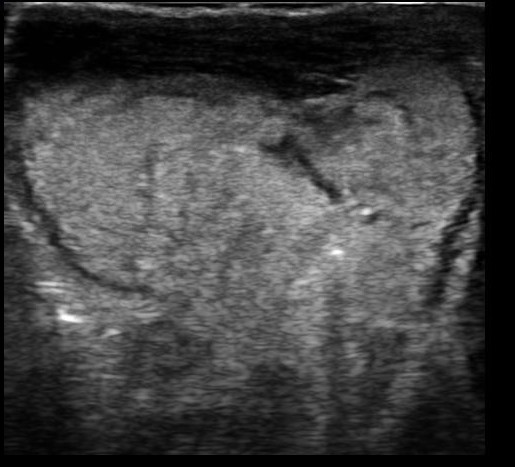
- 4,037 View
- 95 Download
- 1 Web of Science
- 1 Crossref
-
 Abstract
Abstract
 PDF
PDF - Pyocele in infants is rarely described in the literature, but it is an emergent condition that requires rapid recognition and treatment to prevent testicular loss. If peritonitis due to gastrointestinal perforation occurs, abdominal contamination may spread through a patent processus vaginalis in an infant, which may lead to pyocele. We report the cases of three infants with scrotal pyocele due to the spread of infection or inflammatory material from the intraperitoneal cavity through a patent processus vaginalis. Two infants were surgically treated, while the other was treated with percutaneous aspiration and intravenous antibiotic administration. Although rare, pyocele should be considered in the differential diagnosis of acute scrotum in infants, especially in infants who previously had peritonitis due to gastrointestinal perforation.
-
Citations
Citations to this article as recorded by- Neonatal pyocele originating from a urinary tract infection: a case report
Zahra Jamali, Mohammad Shafie’ei, Najmeh Soltani Nejad
Journal of Medical Case Reports.2024;[Epub] CrossRef
- Neonatal pyocele originating from a urinary tract infection: a case report
- Diagnosis and successful visual biofeedback therapy using fiberoptic endoscopic evaluation of swallowing in a young adult patient with psychogenic dysphagia: a case report
- Youngmo Kim, Sang Hun Han, Yong Beom Shin, Jin A Yoon, Sang Hun Kim
- J Yeungnam Med Sci. 2023;40(1):91-95. Published online January 13, 2022
- DOI: https://doi.org/10.12701/yujm.2021.01543
- 3,686 View
- 163 Download
- 1 Web of Science
- 2 Crossref
-
 Abstract
Abstract
 PDF
PDF - Psychogenic dysphagia is a deglutition disorder characterized by a fear of swallowing, with no structural or functional causes. This report presents the case of a young male patient who had severe malnutrition due to psychogenic dysphagia and was provided visual biofeedback using fiberoptic endoscopic evaluation of swallowing (FEES). A healthy 25-year-old man presented to our clinic with a complaint of throat discomfort when swallowing that had started 6 months prior. As the symptoms worsened, he became fearful of food spreading to his lungs after swallowing and the development of respiratory difficulties. His food intake gradually decreased, resulting in a weight loss of 20 kg within 2 months. Evaluation of organic and other functional causes of dysphagia was performed, but no abnormalities were detected. The sensation of a lump in his throat, fear of swallowing, and anxiety were transformed into somatic symptoms. The patient was diagnosed with psychogenic dysphagia. After visual biofeedback by a physician who performed FEES, the patient resumed eating normally and increased his food intake. If routine tests do not reveal structural or functional causes of dysphagia, assessment of a psychogenic swallowing disorder should be considered. FEES can help in the diagnosis and management of psychogenic dysphagia.
-
Citations
Citations to this article as recorded by- Endoscopic Biofeedback Training for Cough and Swallowing: The What, Why, and How
James A. Curtis
Perspectives of the ASHA Special Interest Groups.2024; : 1. CrossRef - The role of laryngeal hypersensitivity in dysphagia: A scoping review with embedded stakeholder involvement
Sophie Chalmers, Fiona Gillies, Sarah Wallace
International Journal of Language & Communication Disorders.2024;[Epub] CrossRef
- Endoscopic Biofeedback Training for Cough and Swallowing: The What, Why, and How
- The endoscopic transnasal approach to the lesions of the craniocervical junction: two case reports
- Baraa Dabboucy, Wissem Lahiani, Damien Bresson, Nouman Aldahak
- J Yeungnam Med Sci. 2023;40(1):96-101. Published online July 20, 2022
- DOI: https://doi.org/10.12701/jyms.2022.00234
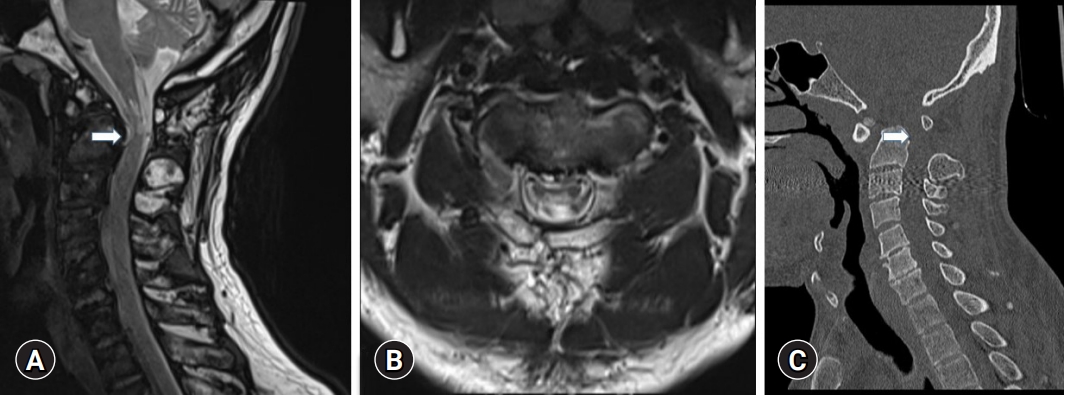
- 2,114 View
- 62 Download
-
 Abstract
Abstract
 PDF
PDF - The endoscopic endonasal approach (EEA) to the craniovertebral junction (CVJ) has recently been considered a safer alternative and less invasive approach than the traditional transoral approach because the complications associated with the latter are avoided or minimized. Here, we present two challenging cases of CVJ pathologies. The first case involved os odontoideum associated with anterior displacement of the occipitocervical junction where the EEA was used, followed by C0-C1-C2 fusion using a posterior approach to decompress the CVJ, and was complicated by rhinorrhea and Candida albicans meningitis. The second case involved basilar invagination with syringomyelia previously treated using a posterior approach, where aggravation of neuropathic symptoms required combined treatment with EEA and occipitocervical fusion of C0-C2-C3-C4, with the postoperative course challenged by operative site infection requiring drainage with debridement and antibiotic therapy. The EEA is an alternative approach for accessing the CVJ in well-selected patients. Knowledge of EEA complications is crucial for the optimal care of patients.
- Intra-abdominal hypertension during hip arthroscopy: a case report
- Saeyoung Kim, Hyun-Su Ri, Ji Hyun Kim, Jiyong Yeom
- J Yeungnam Med Sci. 2023;40(1):102-105. Published online September 23, 2022
- DOI: https://doi.org/10.12701/jyms.2022.00430

- 1,671 View
- 62 Download
-
 Abstract
Abstract
 PDF
PDF - Symptomatic extravasation of irrigation fluid is a rare complication of hip arthroscopy. However, depending on the amount of fluid, intra-abdominal hypertension (IAH) may occur and even develop into abdominal compartment syndrome, which can seriously alter hemodynamic circulation. Therefore, it is important for anesthesiologists to promptly recognize the abnormal signs of IAH for early diagnosis and better clinical outcomes. Nevertheless, these signs are difficult to detect because they are usually obscured when the patient is under anesthesia and masked by surgical drapes. We report a case of IAH under general anesthesia during hip arthroscopy to highlight possible symptoms and signs.

 E-Submission
E-Submission Yeungnam University College of Medicine
Yeungnam University College of Medicine


 First
First Prev
Prev



